| DCA Stuff and constant versus volatile returns |
So there I was, browsing various discussion forums and finding that I didn't understand certain arguments on the difference between investing some fixed annual amount in an asset that provides constant returns vs investing in a volatile market.
>Creeping senility?
Probably.
Anyway, if you invest an amount $A each year and the 1-year, 2-year, 3-year Gain Factors etc.are respectively
G1, G2, G3, etc. then the number of units you'll have after N years is:
[1] U1 = (A/P0)[1 + 1/G1 + 1/G2 + ... + 1/GN]
where P0 is the initial price per unit.
>I assume you can prove that?
It's that Magic Sum, remember? We'll give it a name:
gMS = 1/G1 + 1/G2 + ... + 1/GN
Then we can write:
[1A] U1 = (A/P0)(1 + gMS)
Anyway, if you were to invest in an asset with a constant annual return, say R, then the 1-year, 2-year, 3-year etc.
gains would be (1+R), (1+R)2, (1+R)3 ... so the number of units you'd hold (after N years) would be (using [1]):
[2] U2 = (A/p0)[1 + 1/(1+R) + 1/(1+R)2+ ... + 1/(1+R)N]
>So when is U2 greater than U1? That's the question, right?
No. We'd want to see if the final portfolio value is greater, not the number of units.
However, let's first compare the final number of units.
We can get an exact formula for that sum in U2, however, to get a quick-and-dirty answer, we'll assume that the U2-sum goes on forever
... and that the return R is positive 
Then the U2-sum is simple ... and we'd get:
[2A] U2 = (A/p0)(1 + 1/R)
Let's look at:
gMS = 1/G1 + 1/G2 + ... + 1/GN for the S&P 500 (from 1950 to 2000).
We'd get this Figure 1. It's approaches (about) 6 ... over the long haul.
|
>The long haul is 50 years?
>That's too long! How about, say, 30 years?
Note that, for 30 years starting in 1950 we see
| 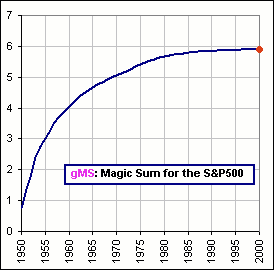 Figure 1 | 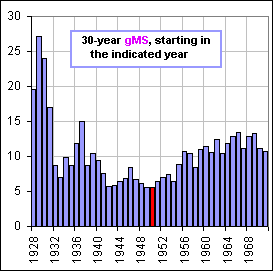 Figure 2 |
>And the portfolio values?
Well, there's a spreadsheet here you can play with, where a set of random returns are
generated and the final portfolio compared to one where there's a constant annual return.
>How about a magic formula?
Well, I suppose we can do this:
- The final value of Portfolio #1 is [final price][number of units] = [P0GN]* [(A/P0)(1 + gMS] = AGN (1 + gMS)
- Similarly, for Portfolio #2 we'd get [p0(1+R)N]*[(A/p0)(1 + 1/R)] = A(1+R)N(1 + 1/R)
- Portfolio #2 would be larger provided:
(1+R)N(1+1/R) > GN (1 + gMS)
or
(1+R) > GN1/N {(1+gMS)/(1+1/R)}1/N
Note that GN1/N is the annualized Gain Factor
- For N large (that's our "long haul") {(1+gMS)/(1+1/R)}1/N would be close to "1".
(For example, if (1 + gMS)/(1 + 1/R) = (1+10)/(1+1/.05) = 0.52 and N = 40 then (0.52)^(1/40) = 0.98) - That'd give the following result:
A constant return greater than the annualized return of a volatile asset will provide a larger (eventual) portfolio
For a one-time, initial investment, your final portfolio will depend only upon the final asset price
... and remember, the annualized return does, indeed, ignore all intermediate prices.
Aah, but for a sequence of annual investments, you'd expect your final portofolio to depend upon these intermediate prices.
What is suggested here is that (approximately, for the long haul) the comparison depends only upon that annualized return.
|
>That equation (1+R)N(1+1/R) > GN
(1 + gMS), what does ...
What does the inequality look like ... graphically? Here's a (typical?) chart 
>And that's exact? You'd need 15% constant return?
>A Rule of Thumb?
Note that the annualized return for the market (or a stock or other asset) is very nearly:
| 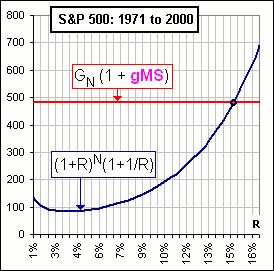 Figure 3 |
Nothing, it's just interesting, don't you think?
>No, and besides ... where's the spreadsheet that'll give Figure 3?
Here.
| Withdrawing with constant and volatile returns |
Mmm ... good question. Now A is the annual withdrawal amount.
If we assume you begin with $A0 (and A0/ P0 units) and withdraw $A each year (starting at the end of the first year), then (for Portfolio #1)
the asset prices at the end of each year would be P0G1, P0G2, etc. etc.
and the units sold each year would be A/(P0/G1), A/(P0/G2), , etc. etc. ... that's Dollars/UnitPrice
and your number of units held (after N years) would be A0/P0 - (A/P0)(1/G1 + 1/G2 + ... + 1/GN) = A0/P0 - (A/P0)gMS
so (multiplying by the final asset price of P0GN) your final Portfolio #1 would be:
[3] A0GN - (A GN)(1/G1 + 1/G2 + ... + 1/GN) = A0GN[1 -w gMS]
where we've set w = A/A0, the annual withdrawal rate.
Important observation #1:
| Portfolio #1 will last N years if w = 1/gMS |
For Portfolio #2 (the "constant return" portfolio) we get the corresponding result by putting
G1 = (1+R), G2 = (1+R)2, ... GN = (1+R)N
and gMS = 1/(1+R)+1/(1+R)2+...+1/(1+R)N = (1/R) { 1-(1+R)-N }
That gives a final Portfolio #2:
[4] A0(1+R)N[1 -(w/R) { 1-(1+R)-N }]
>That's with "long haul" approximations, right?
Uh ... no. We're not doing that Rule of Thumb thingy but using the exact results.
>Why?
Because we're talking about retirement ... and I'm retired 
Important observation #2:
| Portfolio #2 will last N years if w = R/{1-(1+R)-N} |
Okay, now the burning question:
| Which portfolio gives the larger withdrawal rate? |
Portfolio #2 (with constant return R) will give a larger withdrawal rate if
R/{1-(1+R)-N} > 1/gMS
>So we plot the left side vs the right side, eh?
You got it. For various values of 40-year gMS values (which characterizes the volatile asset):
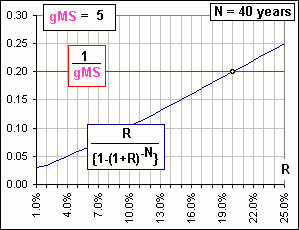
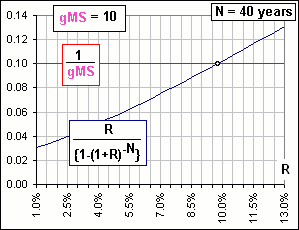

>The dot gives ... what?
It gives the constant return necessary for Portfolio #2 to give a larger withdrawal rate.
>But what value do I give for that gMS?
Stare at Figure 2 and try to guess what future gMS-value is appropriate.
>But Figure 2 gives 30-year values!
Uh ... yes. When I work up some enthusiasm I'll generate some 40-year values ... okay?
>No! Besides, you haven't considered inflation! I mean, my withdrawals would go up with infl...
Well, just use inflation-reduced returns.
That is, instead of a return r, use r/(1+InflationRate)
I might point out that the values of gMS are given in the spreadsheet described
here (where it's called the
MRW, the Maximum Rate of Withdrawal),
for various time periods and various allocations between growth & value stocks and/or bonds etc. etc..
>Then you're off the hook.
Thanks.
